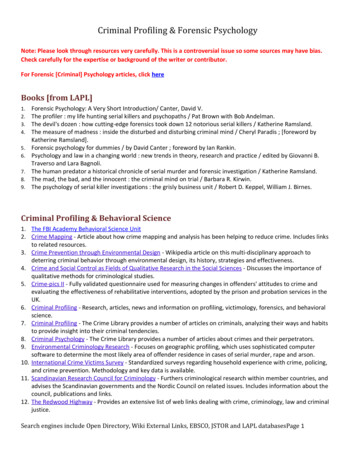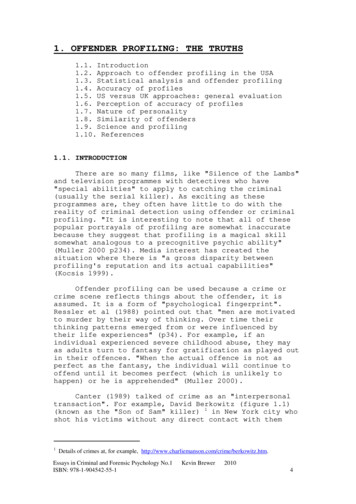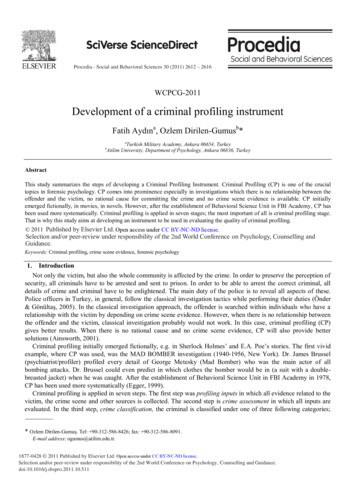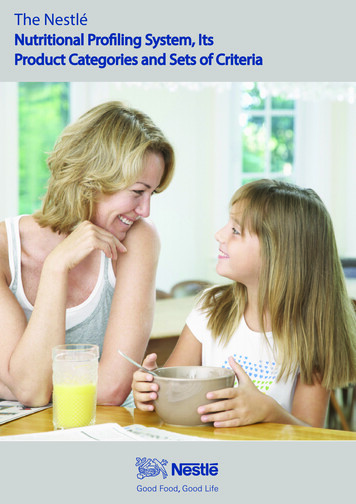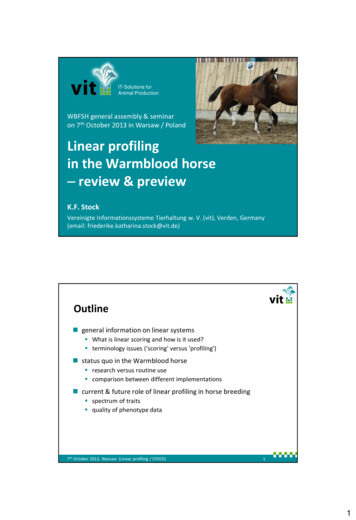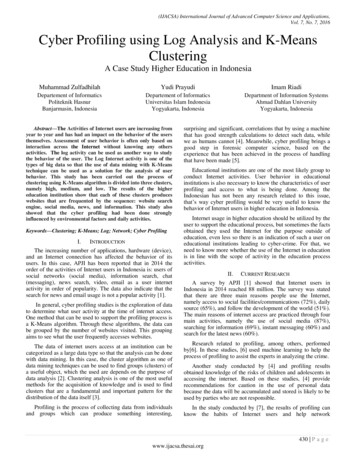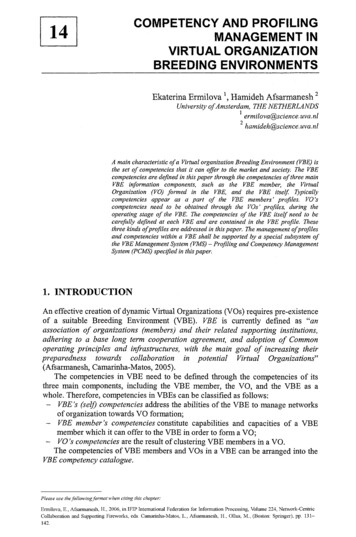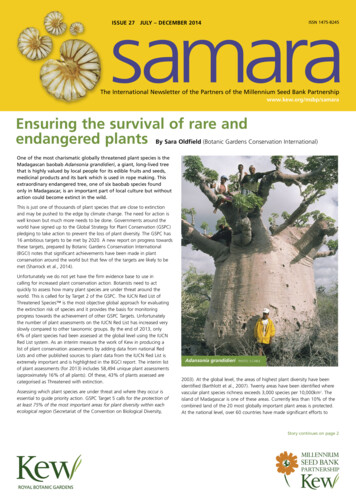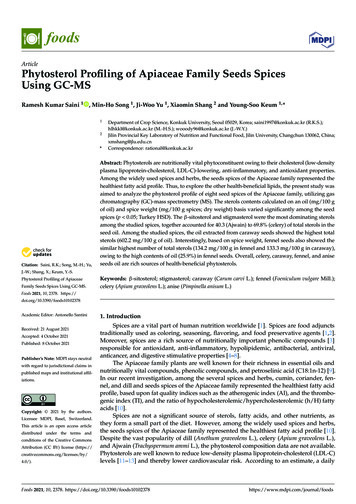
Transcription
foodsArticlePhytosterol Profiling of Apiaceae Family Seeds SpicesUsing GC-MSRamesh Kumar Saini 1 , Min-Ho Song 1 , Ji-Woo Yu 1 , Xiaomin Shang 2 and Young-Soo Keum 1, *12* Citation: Saini, R.K.; Song, M.-H.; Yu,Department of Crop Science, Konkuk University, Seoul 05029, Korea; saini1997@konkuk.ac.kr (R.K.S.);hlhkkl@konkuk.ac.kr (M.-H.S.); wooody96@konkuk.ac.kr (J.-W.Y.)Jilin Provincial Key Laboratory of Nutrition and Functional Food, Jilin University, Changchun 130062, China;xmshang@jlu.edu.cnCorrespondence: rational@konkuk.ac.krAbstract: Phytosterols are nutritionally vital phytoconstituent owing to their cholesterol (low-densityplasma lipoprotein-cholesterol, LDL-C)-lowering, anti-inflammatory, and antioxidant properties.Among the widely used spices and herbs, the seeds spices of the Apiaceae family represented thehealthiest fatty acid profile. Thus, to explore the other health-beneficial lipids, the present study wasaimed to analyze the phytosterol profile of eight seed spices of the Apiaceae family, utilizing gaschromatography (GC)-mass spectrometry (MS). The sterols contents calculated on an oil (mg/100 gof oil) and spice weight (mg/100 g spices; dry weight) basis varied significantly among the seedspices (p 0.05; Turkey HSD). The β-sitosterol and stigmasterol were the most dominating sterolsamong the studied spices, together accounted for 40.3 (Ajwain) to 69.8% (celery) of total sterols in theseed oil. Among the studied spices, the oil extracted from caraway seeds showed the highest totalsterols (602.2 mg/100 g of oil). Interestingly, based on spice weight, fennel seeds also showed thesimilar highest number of total sterols (134.2 mg/100 g in fennel and 133.3 mg/100 g in caraway),owing to the high contents of oil (25.9%) in fennel seeds. Overall, celery, caraway, fennel, and aniseseeds oil are rich sources of health-beneficial phytosterols.J.-W.; Shang, X.; Keum, Y.-S.Phytosterol Profiling of ApiaceaeFamily Seeds Spices Using GC-MS.Keywords: β-sitosterol; stigmasterol; caraway (Carum carvi L.); fennel (Foeniculum vulgare Mill.);celery (Apium graveolens L.); anise (Pimpinella anisum L.)Foods 2021, 10, 2378. https://doi.org/10.3390/foods10102378Academic Editor: Antonello SantiniReceived: 21 August 2021Accepted: 4 October 2021Published: 8 October 2021Publisher’s Note: MDPI stays neutralwith regard to jurisdictional claims inpublished maps and institutional affiliations.Copyright: 2021 by the authors.Licensee MDPI, Basel, Switzerland.This article is an open access articledistributed under the terms andconditions of the Creative CommonsAttribution (CC BY) license (https://creativecommons.org/licenses/by/4.0/).1. IntroductionSpices are a vital part of human nutrition worldwide [1]. Spices are food adjunctstraditionally used as coloring, seasoning, flavoring, and food preservative agents [1,2].Moreover, spices are a rich source of nutritionally important phenolic compounds [3]responsible for antioxidant, anti-inflammatory, hypolipidemic, antibacterial, antiviral,anticancer, and digestive stimulative properties [4–8].The Apiaceae family plants are well known for their richness in essential oils andnutritionally vital compounds, phenolic compounds, and petroselinic acid (C18:1n-12) [9].In our recent investigation, among the several spices and herbs, cumin, coriander, fennel, and dill and seeds spices of the Apiaceae family represented the healthiest fatty acidprofile, based upon fat quality indices such as the atherogenic index (AI), and the thrombogenic index (TI), and the ratio of hypocholesterolemic/hypercholesterolemic (h/H) fattyacids [10].Spices are not a significant source of sterols, fatty acids, and other nutrients, asthey form a small part of the diet. However, among the widely used spices and herbs,the seeds spices of the Apiaceae family represented the healthiest fatty acid profile [10].Despite the vast popularity of dill (Anethum graveolens L.), celery (Apium graveolens L.),and Ajwain (Trachyspermum ammi L.), the phytosterol composition data are not available.Phytosterols are well known to reduce low-density plasma lipoprotein-cholesterol (LDL-C)levels [11–13] and thereby lower cardiovascular risk. According to an estimate, a dailyFoods 2021, 10, 2378. dpi.com/journal/foods
Foods 2021, 10, 23782 of 17intake of 3 g plant sterols/stanols reduced serum LDL-C concentrations by 12% [12].Moreover, as an antioxidant, plant sterols, such as campesterol, β-sitosterol, stigmasterol,and scavenge the harmful reactive oxygen spices and thus prevent lipid peroxidation [14].Furthermore, animal and human studies have demonstrated the anti-inflammatory effectsof phytosterols [15]. Considering these facts, although spices form a small part of the diet,consuming phytosterol-rich spices may improve the health benefits of the diet.Moreover, among the previous studies, a significant variation exists in the sterolcomposition of Apiaceae family seeds spices. For instance, in oil extracted from coriander(Coriandrum sativum L.) seeds, β-sitosterol contents are reported from 100.9 mg/100 g [16]to 231.4 mg/100 g [17]. Similarly, in oil extracted from anise (Pimpinella anisum L.) seeds, βsitosterol contents are reported from 211.6 mg/100g [18] to 626.4 mg/100 g [16]. Moreover,recently, Balbino et al. [18] recorded a significant amount of α-spinasterol (206.2 mg/100 goil) in anise seed oil, while it was not detected in previous studies [16,19].Furthermore, many studies reported the sterol composition of Apiaceae family seedsutilizing a gas chromatography (GC)-flame ionization detection (FID) based analysismethod [16,19–21], which may yield a misidentification of compounds eluting at a similarretention time. This problem can be eliminated in the gas chromatography (GC)-massspectrometry (MS) based method, as the fragment ions of analytes are also compared withthe standards.In view of the above-listed facts, a detailed and comparative phytosterols profile ofseeds spices of the Apiaceae family may be helpful to identify those with health-beneficialpotential. Thus, the present study was aimed to analyze the phytosterol profile of eight mostwidely used seed spices of the Apiaceae family, namely dill (Anethum graveolens L.), celery(Apium graveolens L.), caraway (Carum carvi L.), coriander (Coriandrum sativum L.), cumin(Cuminum cyminum L.), fennel (Foeniculum vulgare Mill.), anise (Pimpinella anisum L.), andAjwain (carom; Trachyspermum ammi L.) utilizing a recently validated GC-MS method [22].2. Materials and Methods2.1. Plant Material, Reagents, and StandardsA total of eight commercially packed seed spices (200–500 g each spice from at leastthree different brands) of the Apiaceae family, namely dill (Anethum graveolens L.), celery(Apium graveolens L.), caraway (Carum carvi L.), coriander (Coriandrum sativum L.), cumin(Cuminum cyminum L.), fennel (Foeniculum vulgare Mill.), anise (Pimpinella anisum L.), andAjwain (carom; Trachyspermum ammi L.) (Appendix A) were obtained from retail outletsin Seoul, Korea. The spice samples of different brands were mixed in equal proportions(200–300 g total) to make a representative sample, ground into a fine powder using a7010HG laboratory blender (Waring Commercial, Torrington, CT, USA), placed into anair-tight container, and stored at room temperature.The standard sterol compounds, campesterol, stigmasterol, β-sitosterol, α-spinasterol,and epicoprosterol (internal standard) were obtained from Merck Ltd., Seoul, Korea. Theorganic solvents used for the extraction of lipids were of high-pressure liquid chromatography (HPLC) grade, obtained from Samchun Chemical Co., Ltd., Seoul, Korea.2.2. Extraction of SterolsCrude lipids containing sterols were extracted from grounded seeds spices followingthe recently optimized protocol [10,22], with minor modifications based on the previousreport [23]. The butylated hydroxytoluene (BHT: w/v; synthetic antioxidant; Merck Ltd.,Seoul, Korea) was added to the extraction solvent (0.75%, w/v) to minimize the degradation of sterols [24]. The total crude lipids were hydrolyzed [23], silylated utilizingN,O-bis(trimethylsilyl)trifluoroacetamide (BSTFA) containing 1% trimethylchlorosilane(TMCS), and analyzed by GC-MS. A detailed extraction, hydrolysis, and silylation procedure is illustrated in Appendix B.
Foods 2021, 10, 23783 of 172.3. GC-MS Analysis of SterolsSterols were analyzed after silylation with trimethylsiloxy groups [TMS; O-Si(CH3 )3 ]utilizing QP2010 SE GC-MS equipped with a fused silica Rxi-5ms column (30 m, 0.5 µmfilm thickness, 0.25 mm ID; Restek Corporation, Bellefonte, PA, USA). Helium was used asa carrier gas maintained at the pressure control flow of 62.1 kPa (7.8 mL/min total flow).The injector and MS ion source were precisely maintained at 275 C, while the MSinterface was maintained at 280 C. The column oven temperature was kept at 120 C for1 min, then progressively increased to 300 C with the linear increase of 15 C/min, andheld at 300 C for 27 min [22]. The 1 µL of samples and standards were injected utilizingan autosampler. For the identity confirmation, retention time and fragmentation patternwere compared with authentic standards and reference databases (NISTO8S, NIST08, andWiley9). The sterols were quantified using the six-point calibration curve (25–400 µg/mL)of standard sterols.The GC-MS method used for the quantification of sterols was validated (in terms ofaccuracy, linearity, precision, and stability) in our recent study [22]. The limit of detection (LOD) of quantified sterols assessed based on the standard deviation of the GC-MSresponse and the slope [25] was recorded above the 8.14 µg/mL, while and limits of quantitation (LOQ; 3.3 LOD) was above the 24.42 µg/mL. Recoveries of sterols were preciselymonitored and normalized using epicoprosterol (5β-cholestan-3α-ol) as internal standards.2.4. Statistical AnalysisA total of six replicate extraction and analysis were performed for each representative spices sample. The results were analyzed using IBM SPSS statistics (version 25)employing a one-way analysis of variance (ANOVA), considering a significance level of0.05 (Turkey HSD).3. Results and Discussion3.1. Identification of Sterols by GC-MSThis study analyzed seed spices of the Apiaceae family, namely dill, celery, caraway, coriander, cumin, fennel, anise, and Ajwain, for sterol profile utilizing GC-MS afterderivatization with trimethylsiloxy groups [TMS; O-Si(CH3 )3 ]. Studied spices showeda significant variation for the oil composition, recorded between 17.5 (anise) to 31.1%(Ajwain) (Figure 1). In the extracted oil, β-sitosterol (stigmast-5-en-3β-ol)-TMS and stigmasterol (stigmasta-5,22-dien-3β-ol)-TMS was found to be the most dominating, followedby an unidentified sterol 2 (m/z 486), and campesterol (ergost-5-en-3 β-ol)-TMS (Figure 2and Appendix C). All the identified sterols were confirmed by retention time and massspectrum with authentic standards. The mass spectrum of sterols identified from studiedspices is shown in Figure 3. Similarly, the mass spectrum of three minor unidentifiedsterols are given in Appendix D. These sterols were quantified using the calibration curveof β-sitosterol. In the present study, the GC-MS method utilized for the identification ofmajor sterols was found efficient, as the interfering non-sterols peaks (eluting with sterols)were eliminated (Figure 3 and Appendix C). However, with the interference of non-sterolscompounds (peaks), GC-FID analysis may result in an error in the identification, as thistechnology is based only on retention time.
Foods 2021, 10, 2378Foods 2021, 10, x FOR PEER REVIEW4 of 174 of 1735.031.1a30.0% 0.0DillCeleryCaraway Coriander tscontents(%,(%,drydryweightbasis)recordedin cordedin theApiaceaefamilyspices.TheThevaluesarea The mean value is signifi‐aremean .Foods 2021, 10, meanx FOR PEERREVIEWdeviation, from an average of six determinations. a The mean value is significantly 5 of 16 standardcantly highest among the studied spices (p 0.05; Turkey HSD).highest among the studied spices (p 0.05; Turkey HSD).(x10, 000,000)1.25IS22, Celery1.0030.7510.50*0.2522. 023.024.0U2U1**25. 026.027.028. 029.030.031. 0U332.033.0(x10, 000,000)*1.003, Caraway3IS1.2520.75*0.50U21*U1 *U30.2522. 023.024. 025.026.027. 028.029. 030.031.032. 033.0(x10, 000,000)1.25IS6, Fennel2*1.000.753*0.50*U2U1U31*0.2522. 023.024.025. 026.027.028. 029.030.031. 032.033.0(x10, 000,000)Figure 2.ISCont.7, Anise1.2521.00340.750.50**1U1U2
0.753*0.50*Foods 2021, 10, 2378U2U1U31*5 of 170.2522. 023.024.025. 026.027.028. 029.030.031. 032.033.0(x10, 000,000)7, AniseIS1.2521.00340.75**0.50122. 023.024.025. 026.0U1*0.2527.0U228. 029.030.0U331. 032.033.0Figure 2. The gas chromatography (GC)- total ion chromatograms (TICs) of sterols identified fromFigure 2. The gas chromatography (GC)- total ion chromatograms (TICs) of sterols identified from celery, caraway, fennel,celery, caraway, fennel, and anise seeds (seed oil). The peak numbers are as follows: (1) campesterol,and anise seeds (seed oil). The peak numbers are as follows: (1) campesterol, (2) stigmasterol, (3) β-sitosterol, and (4) α(2) IS:stigmasterol,(3) β-sitosterol,and5β-cholestan-3α-ol;(4) α-spinasterol.CASIS: 516-92-7);internal standard(epicoprosterol;spinasterol.internal standard(epicoprosterol;U: unidentified;* non-sterols5βcomFoods 2021, 10, x FOR PEER REVIEW6 of 17pounds. cholestan-3α-ol; CAS 516-92-7); U: unidentified; * non-sterols compounds.%129 [TMSOH] 1001. Campesterol‐TMS,m/z 47275[M‐129] 5073Si10717521353%100[M] 47215950382Loss of TMSOH with side chain250[M‐90] 343O95150255233200[M‐CH3] 4572892503153403004163504505002. Stigmasterol‐TMS,m/z 4848310048740075[TMSOH] 5055129Loss of TMSOH with side chain[M‐CH3] 2511925515951050100150200351282484379330250300[M] 394355213228173[M‐90] [M‐129] 418 441350400469450500%129 [TMSOH] 1003. β‐Sitosterol‐TMS,m/z 48675[M‐129] 735035795121396 [M‐90] Loss of TMSOH with side 34310083255754505004. α‐Spinasterol‐TMS,m/z 484Loss of side chain with 2H5550400486471458429350[M] [M‐CH3] 255Loss of TMSOH with side chain107145213 229[M‐CH3] 173281050100150200250379318303300394350[M] 48446925400441450500Figure3. The3.gasThechromatography(GC)‐mass spectra (GC)-massof most abundantsterols identifiedin theFiguregas chromatographyspectraof mostabundant sterols identified in thepresent study from the seed spices of the Apiaceae family. The mass spectra of campesterol, amily.Themassspectra of campesterol, stigmasmasterol, and β‐sitosterol are from celery, while α‐spinasterol is from Ajwain.terol, and β-sitosterol are from celery, while α-spinasterol is from Ajwain.In the mass spectrometric identification of sterols, an ion at m/z [M‐90] , for the lossof trimethylsilanol (TMSOH), and loss of the TMSOH with side chain is a common feature
Foods 2021, 10, 23786 of 177 of 17 , for theIn the mass spectrometric identification of sterols, an ion at m/z [M-90]loss of trimethylsilanol (TMSOH), and loss of the TMSOH with side chain is a commonfeature [26,27]. The 5-sterol TMS derivatives, such as campesterol, stigmasterol, and[26,27].The Δ5‐sterolderivatives,such as andcampesterol,stigmasterol,and β‐sitosterolβ-sitosterolgive ninvolving loss ofgiveparticularly eldingof the TMS‐thea TMS-grouptogetherandwithC-l, C-2, andC-3 of the sterolA-ring,intense ions at ��ring,yieldingintenseionsatm/z129m/z 129 for the TMS derivative-containing fragment and m/z [M-129] for the remaining for the remaining portionforportionthe TMSofderivative‐containingandm/z In[M‐129]the sterol (Figuresfragment3 and 4)[26].contrast,the 7-sterol TMS derivatives,of thesterol(Figures 3 andproduce4) [26]. Incharacteristicscontrast, the Δ7‐sterolTMS derivatives,α‐ with two by losingsuchsuchas α-spinasterol,ion[M-141]sideaschainspinasterol, produce characteristics ion [M‐141] by losing side chain with two hydrogenshydrogens (Figure 3) [28].Foods 2021, 10, x FOR PEER REVIEW(Figure 3) [28].SiO-Sitosterol; (3 )-Stigmast-5-en-3-olTMS derivativatizationm/z 486SiOLoss of trimethylsilanol (TMSOH)SiOm/z 129Loss of the TMSOH with C1, C2 and C3Sim/z [M - 90] 396Om/z 129m/z [M - 129] 357Loss of the TMSOH with side chainSiOm/z [M - TMSOH - side chain] 255Figure 4.4.Themassspectrometricfragmentationpattern ofβ‐sitosterol(TMS derivative)in theobservedpresent nof β-sitosterol(TMSobservedderivative)in the present[26–28].study [26–28].
Foods 2021, 10, 23787 of 17As evident from the identified sterols, the mass spectra were different among 5(campesterol, stigmasterol, and β-sitosterol) and 7-sterols (α-spinasterol) (Figure 3). Moreover, 5,7-sterol (e.g., ergosterol) commonly occur in food, especially mushrooms [22],which may yield different mass spectra. In the present study, the unidentified sterol 1showed [M] , [M-CH3 ] , [M-side chain with 2H] , and [TMSOH] fragment ions(Appendix D). In the previous studies, a significant amount of 5-avenasterol (stigmasta5,24-dien-3β-ol) has been recorded in the Apiaceae family seed spices, especially in coriander [16,21] and fennel [20]. In the present study, probably the unidentified Compound 1 is 5-avenasterol (which may yield the m/z of 484; TMS derivative); however, other majorfragments, such as m/z 394 [M-90] and m/z 355 [M-129] were not observed, whichwere the common fragments of 5-sterol TMS (campesterol, stigmasterol, and β-sitosterol)recorded in the present study.The unidentified Sterol 2 showed [M] at surprisingly high intensity, with [M-CH3 ] and [M-TMSOH-side chain with 2H] . In contrast, the unidentified Sterol 3 showed[M-TMSOH-side chain with 2H] at high intensity, similar to α-spinasterol, suggestingthat this is probably a 7-sterol TMS. However, their identity was not confirmed, as GC-MSalone is not adequate to elucidate the identity of unknown sterols [29].3.2. Sterol Contents in Studied SpicesIn the present study, the studied spices showed significantly different contents ofindividual and total sterols (p 0.05; Turkey HSD). Sterols contents calculated as oilbasis (mg/100 g of oil) and spice weight basis (mg/100 g spices) were given in Table 1and Figure 5, respectively. Among the studied spices, the highest contents of total sterolFoods 2021, 10, x FOR PEER REVIEW were recorded in the oil extracted from caraway (602.2 mg/100 g oil), followed by9 aniseof 17(551.9 mg/100 g oil) and celery (546.2 mg/100 g oil) (Table 1). Interestingly, based on spiceweight (Figure 5), fennel seeds also showed the similar highest number of total sterolsa notmg/100fennel ofand133.3mg/100 g in n.d.;caraway,dry weightbasis; andwereValues are mean standard(134.2deviationfrom ganinaveragethreedeterminations.not detected;RT: retentiontime.statisticallysignificantat p spices0.05, Turkeythe thehighcontentsof oil(25.9%)The mean value is significantlyhighest amongthe studied(p ��in 3fennelseeds witha considerableamountsterols.spond to those used in Figureand AppendixC. Them/z values arefrom theofTMSderivative of each sterol .6sterols (mg/100g 0Total sterols (mg/100g itosterolα‐Spinasterol‐Unidentified 1 (m/z 484)Unidentified 2 (m/z 486)Unidentified 3 (m/z 484)TotalFigureFigure 5.5. PhytosterolPhytosterol compositioncomposition s)basis) ofof studiedstudied ApiaceaeApiaceae familyfamily seedseed spices.spices. ValuesValues arearemean standard deviation of six replicates. The secondary axis represents the line graph. aaThe mean value is significantlymean standard deviation of six replicates. The secondary axis represents the line graph. The mean value is significantlyhighest among the studied spices (p 0.05; Turkey HSD).highest among the studied spices (p 0.05; Turkey HSD).Among the sterol compounds, β‐sitosterol was found to be the most dominating inthe oil extracted from caraway (243.1 mg/100 g oil), cumin (196.3 mg/100 g oil), and cori‐ander (121.7 mg/100 g oil), account for 40.4, 39.3, and 31.5% of total sterols, respectively.Interestingly, stigmasterol was most dominating in oil extracted from celery (228.6 mg/100g oil), fennel (182.4 mg/100 g oil), and dill (109.3 mg/100 g oil), accounted for 41.8, 35.3,and 30.3% of total sterols, respectively.
Foods 2021, 10, 23788 of 17Among the sterol compounds, β-sitosterol was found to be the most dominating in theoil extracted from caraway (243.1 mg/100 g oil), cumin (196.3 mg/100 g oil), and coriander(121.7 mg/100 g oil), account for 40.4, 39.3, and 31.5% of total sterols, respectively. Interestingly, stigmasterol was most dominating in oil extracted from celery (228.6 mg/100 goil), fennel (182.4 mg/100 g oil), and dill (109.3 mg/100 g oil), accounted for 41.8, 35.3, and30.3% of total sterols, respectively.In agreement with the present investigation, Balbino et al. [18] also recorded thedominance of campesterol, stigmasterol, and β-sitosterol in seed spices of the Apiaceaefamily, with stigmasterol as the dominating sterol in the oil extracted from fennel, andβ-sitosterol in caraway and coriander seed oil. However, Balbino et al. [18] recordedsignificantly higher contents of β-sitosterol, stigmasterol, and α-spinasterol, and total sterolin anise seed oil than the contents recorded in the present investigation.In the present study, the highest amount of α-spinasterol was recorded in aniseseed oil (109 mg/100 g oil; 19.9% of total sterols), with a significant presence in dill(62.6 mg/100 g oil), and Ajwain seed oil (98.1 mg/100 g oil). In agreement with the presentstudy, Balbino et al. [18] record a significant amount of α-spinasterol in anise seed oil, whileit was not detected in previous studies [16,19].A significant variation is recorded in the previous studies for the phytosterol profileof seed spices of the Apiaceae family (Table 2). Ramadan [21] recorded stigmasterol as themost dominating (29.8% of total sterol) in the coriander seeds oil, with dominating amountof β-sitosterol (28.2% total sterol), 5-avenasterol (23.8% of total sterol). However, in thepresent investigation, in coriander seed oil β-sitosterol was the most dominating (31.5%total sterol), followed by stigmasterol (28.0% of total sterol). In addition, Kozłowska [16]recorded the stigmasterol as the most dominating in coriander and caraway seeds oil, witha significant amount of 5-avenasterol.Islam et al. [20] detected stigmasterol (57.6 mg/100 g seeds), β-sitosterol (48.8 mg/100 gseeds), and 5-avenasterol (40.9 mg/100 g seeds) as the dominating sterols in fennel seeds,with total sterol contents of 156.3 mg/100 g seeds, which is slightly higher than recordedin the present study. In the present study, campesterol accounted for 9.9% of total sterol;whereas, Hosseini [30] recorded 49.19% campesterol in cumin seeds oil. Heredity (cultivar/variety) [31,32], geographical conditions [33], and several other different biotic andabiotic factors [34] during cultivation and storage [35] are probably responsible for a significant variation in sterol contents and compositions among plants. Thus, the factorsinfluencing sterols contents positively can be identified and utilized for enhancing thesterols contents in the food crops and diet.In view of the health benefits of phytosterols in reducing the LDL-C levels [11–13] withantioxidant [14] and anti-inflammatory properties [15], consumption of phytosterol-richseeds spices, such as celery, caraway, fennel, and anise seeds may improve the healthbenefits of the diet.
Foods 2021, 10, 23789 of 17Table 1. Phytosterol composition of studied spices (mg/100 g of oil).Peak Sitosterolα-SpinasterolUnidentified 1(m/z 484)Unidentified 2(m/z 486)Unidentified 3(m/z 484)TotalRT (min)m/z (M] 27.14127.99129.86129.90447248448648420.8 4.0109.3 6.357.4 4.062.6 1.453.6 1.9228.6 1.3 a152.7 4.0n.d.47.4 1.0156.9 7.1243.1 5.9 an.d.33.4 0.8108.2 4.0121.7 6.2n.d.49.2 6.3175.4 8.0196.3 8.1n.d.19.8 1.7182.4 1.7132.9 4.5n.d.19.3 0.5129.9 6.2121.7 0.7109.9 1.3 a27.5 0.387.7 2.964.0 8.598.1 7.730.390484n.d.39.2 0.138.1 4.723.9 16.529.4 2.266.4 16.5 a24.7 2.720.4 0.132.04548693.7 6.449.5 3.175.3 4.373.7 1.831.9 1.085.4 0.6121.2 4.6 a63.3 4.032.95148417.5 0.122.7 1.941.4 0.5 a25.5 1.317.3 4.930.4 3.225.2 0.615.2 1.7386.4 28.1499.5 30.5517.3 28.3551.9 14.0376.2 5.5361.4 22.4546.2 12.4602.2 12.9aaValues are mean standard deviation from an average of three determinations. n.d.; not detected; RT: retention time. The mean value is significantly highest among the studied spices (p 0.05; Turkey HSD).Peak: the peak numbers correspond to those used in Figure 3 and Appendix C. The m/z values are from the TMS derivative of each sterol compound.
Foods 2021, 10, 237810 of 17Table 2. Phytosterol composition of Apiaceae family seeds spices reported in previous lαSpinasterol 7Stigmasterol 7Avenasterol 5AvenasterolTotal 913.322.119.226.87.8920.1 c5.9824.1 c5.438.8 a61.1 a31.7 a49.0 a36.6 a44.4 a50.8 a214 a35.0 a49 a9.0 b67.7 a119 a91.1 a160.3 a79.1 a245.4 a109.6 a118.0 a136.9 a154.8 a73.3 a172.5 a223 a57.6 b206.9 a118 a67.9 a240.2 a226.6 a244.9 a177.6 a100.9 a231.4 a146.4 a104.1 a140.2 a161 a48.8 b211.6 a238 a626.4 a19.8 an.d.n.d.18.3 an.d.n.d.n.d.n.d.19.7 an.d.n.d.206.2 an.d.n.d.29.3 a10.7 an.d.70.3 an.d.106.4 an.d.14.0 a53.0 an.d.n.d.140.4 an.d.n.d.46.4 a8.8 a23.7 a24.3 a15.2 a26.9 a24.4 a5.4 a30.9 a18 an.d.47.0 a9an.d.n.d.0.8 a87.1 an.d.54.4 a21.0 a123.5 a11.5 an.d.6a40.9 bn.d.3an.d.570.3 a405 a739.4 a468.8 a358.4 a629 a518.6 a426 a492.4 a464 a156.3 b903.9 a385 a849.9 7][21][30][18][19][20][18][19][16](mg/100 g oil); b (mg/100 g seeds); c highest oil yield utilizing Folch method. GC-FID: gas chromatography (GC)-flame ionization detection (FID); GC-MS: GC-mass spectrometry. Campesterol (ergost-5-en-3β-ol; CAS 474-62-4), stigmasterol ( 5-Stigmasterol; stigmasta-5,22-dien-3β-ol; CAS 83-48-7), β-sitosterol (stigmast-5-en-3β-ol; CAS 83-46-5), α-spinasterol ((22E)-stigmasta-7,22-dien-3ß-ol; CAS 481-18-5)), 7-stigmasterol (Stigmasta-5,7,22-trien-3-ol; CAS 481-19-6), 7-avenasterol (Stigmasta-7,24(28)-dien-3-ol; CAS 23290-26-8), and 5-avenasterol (stigmasta-5,24-dien-3β-ol; CAS 18472-36-1).
Foods 2021, 10, 237811 of 174. ConclusionsThe GC-MS is an efficient method for sterol profiling, as the interfering non-sterolspeaks (eluting with sterols) are eliminated. To the best of our knowledge, this is the firstreport of the GC-MS profile of phytosterols from dill, celery, and Ajwain seeds. The presentstudy revealed that the phytosterol profile substantially varies among seed spices of the Apiaceae family. Among the studied spices, the oil extracted from caraway seeds showed thehighest total phytosterols (602.2 mg/100 g of oil). In addition, oil extracted from caraway,fennel, and anise seeds were also recorded rich in phytosterols (517.3–551.9 mg/100 g ofoil). Consumption of these spices may provide health benefits [11–15]. In the future, moredetailed studies can help to uncover the identity of unidentified sterols.Author Contributions: Conceptualization, R.K.S. and Y.-S.K.; methodology, R.K.S.; validation, R.K.S.and Y.-S.K.; formal analysis, R.K.S.; investigation, R.K.S.; resources, Y.-S.K.; writing—original draftpreparation, R.K.S.; writing—review and editing, X.S.; supervision, Y.-S.K.; project administration,M.-H.S. and J.-W.Y.; funding acquisition, R.K.S. All authors have read and agreed to the publishedversion of the manuscript.Funding: This research was supported by the Konkuk University Research Fund (2021A0190061).Institutional Review Board Statement: Not applicable.Informed Consent Statement: Not applicable.Data Availability Statement: Data is contained within the article.Acknowledgments: This paper was supported by the KU research professor program of KonkukUniversity, Seoul, Republic of Korea.Conflicts of Interest: The authors declare no conflict of interest.
Institutional Review Board Statement: Not applicable.Informed Consent Statement: Not applicable.Data Availability Statement: Data is contained within the article.Foods 2021, 10, 2378of 17Acknowledgments: This paper was supported by the KU research professor program of 12KonkukUniversity, Seoul, Republic of Korea.Conflicts of Interest: The authors declare no conflicts of interest.Appendix AAppendix idishdishisisFigure90 mm.90 mm.
Foods 2021, 10, 2378Foods 2021, 10, x FOR PEER REVIEW13 of 1713 of 17AppendixB BAppendix8g of finely ground spice sample was precisely weighed and transferred to a 250 mLconical flask Samples were homogenized with 100 mL (isopropyl alcohol/cyclohexane, 10:12,v/v) containing 0.075% butylated hydroxytoluene (BHT: w/v; antioxidant)
The sterols contents calculated on an oil (mg/100 g of oil) and spice weight (mg/100 g spices; dry weight) basis varied significantly among the seed spices (p 0.05; Turkey HSD). The -sitosterol and stigmasterol were the most dominating sterols among the studied spices, together accounted for 40.3 (Ajwain) to 69.8% (celery) of total sterols in .
